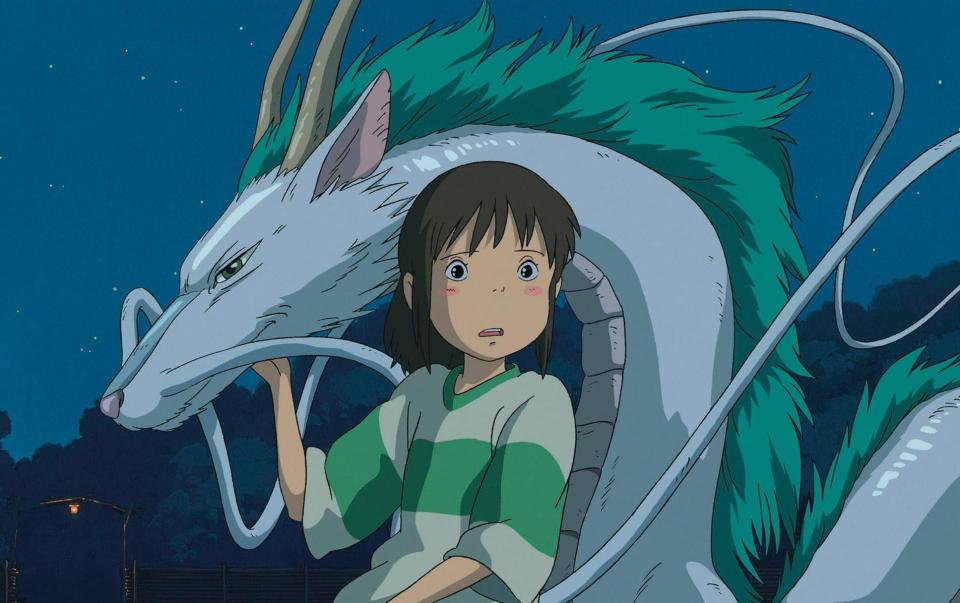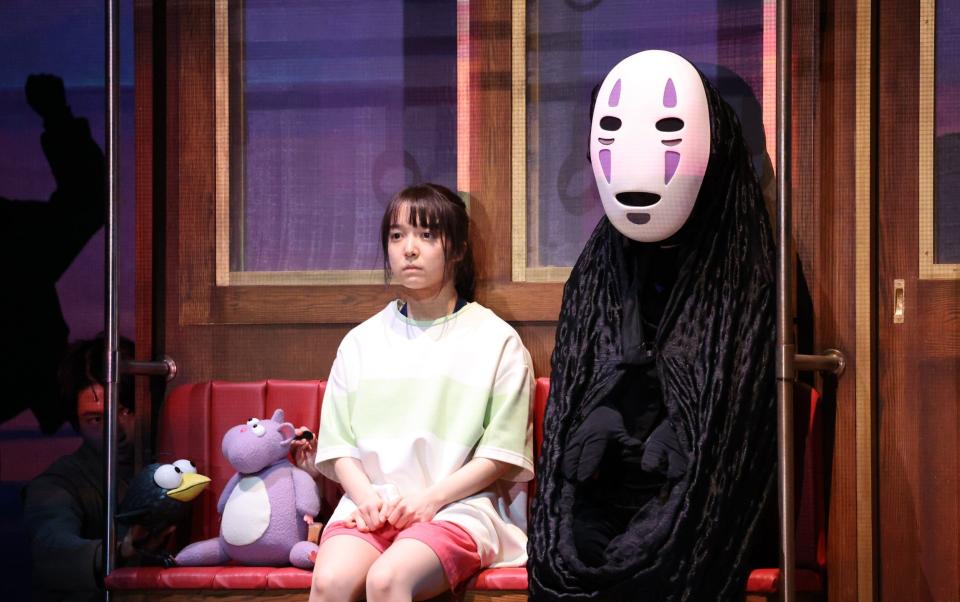It is a gray spring morning in London and on the sidewalk in Covent Garden there is a box containing the head of an old woman.
Or rather: parts of it. The head is in pieces because it wouldn’t fit: it’s about eight feet long and even wider, with eyes as big as cauldrons, teeth like bricks, and a huge nose that sticks out from under the eyelid like a finger. I’m ticking you off for peeking in.
Fans of Studio Ghibli animation would immediately recognize it as belonging to Yubaba from Spirited Away, the sorceress usually found on the top floor of the enchanted bathhouse from the 2001 film. This year, however, the old girl is on tour.
After a sold-out edition in Tokyo and a series of Japanese cities, the stage adaptation of Ghibli’s Oscar-winning animated fantasy moves into the London Coliseum. About seventy puppets, many of them enormous, are wheeled around the theater like gods on palanquins, while the backstage corridors are lined with bilingual signs: dressing rooms this way, canteen that.
Unlike the Royal Shakespeare Company’s (unrelated) production of My Neighbor Totoro, which has just completed its second season at the Barbican and will move to the West End next year, Spirited Away first opened in Japan and will be performed here by the original cast. . Yet the British transfer is something of a homecoming. The show is directed and adapted by John Caird, a veteran of the RSC and National Theatre, whose original 1985 production of Les Misérables ran for 34 years in London’s West End. The creatures were created by Toby Olié, the puppeteer behind War Horse. The set designer is Jon Bausor, also from the RSC, who designed the opening ceremony of the 2012 Paralympic Games.
Most unlikely of all, it was conceived just down the road, in a church hall in Dalston. Caird had pitched the play to Spirited Away writer and director Hayao Miyazaki just before the pandemic – more on that later – and by the time he could start working on it he was back in Britain, because the theater world (and others) ) came to a stop.
Six months before rehearsals were to begin in Tokyo, Caird, Olié and Bausor met regularly in the vaulted upper hall of Saint Barnabas to consider the task of presenting Miyazaki’s extraordinary creation.
to life.
The most obvious challenge was the film’s supernatural menagerie, inspired by the kami, or “local gods,” of Japan’s Shinto religion. (Olié built miniature prototypes of these in his workshop.) But they also had to give dramatic meaning to the oddly shaped plot – which, like all Miyazaki’s films, was conceived as a series of hand-drawn pictures rather than words. on a page.
Centered around a young girl named Chihiro who reluctantly takes a job at a magical hot spring resort, it’s an Alice in Wonderland story as only Miyazaki can tell: a child reckoning with the strangeness of the world on his way to adulthood, but also determinedly seeks to reform it in its image, even as it conspires to reform it in its own image. To the layman, it also looks like an adapter’s nightmare, with its soaring dragons, billowing water and cascading vertical drops all seeming impossible to recreate on stage.
“It’s interesting that you use the word ‘impossible,’” chuckles Caird, an owlish 75, as he drinks tea in his office across the street from the theater. “Every day in rehearsal I started by saying to the cast and crew, ‘Today’s impossible task is…’”
For Caird, the fog of impossibility began to lift when he made the connection between Miyazaki’s masterpiece and noh – the classic Japanese form of masked theatre, which is also teeming with gods and spirits. The grand entrance to Spirited Away’s bathhouse reminded Caird of the wooden noh stage, a sacred space that performers access via a bridge — and suddenly, 700 years ago, he had the foundation of his set. Similarly, Caird and Olié draw on bunraku, traditional Japanese puppetry in which elaborate mannequins are brought to life by performers whose own acrobatic movements can become part of the act, for the creatures.

Caird had been wanting to make something Japanese for a while. Since 2007 he has directed a number of productions in Tokyo, but they were all of Western origin: Les Misérables, of course; a bit of Bernstein and Wilde; a lot of Shakespeare. So when entertainment conglomerate Toho asked him to devise a new project for the capital’s vast Imperial Theater, Spirited Away came to mind.
He had seen the film on its first western release, but had never thought about adapting it until Toho’s offer came through and the brainwave hit the noh stage. Then came the matter of convincing Ghibli that it would work. Caird arranged a meeting with Joe Hisaishi, the composer of the legendary film score, to request permission to use his music in the show. (Hisaishi was so excited at the thought of it finding an audience abroad, his only suggestion was that they skip the Japanese run and start in Europe.) But that required a meeting to be scheduled at Ghibli’s headquarters in Tokyo in the leafy suburb of Mitaka, where Caird and his producer met Toshio Suzuki, one of the studio’s co-founders.
“About 30 seconds after we entered Suzuki-san’s office, Miyazaki himself walked in, wearing his work apron, and sat down,” Caird recalls. “We didn’t expect him to join us at all, but as nerve-wracking as it was, I knew at that moment that we were in with a shot.”
To Caird’s surprise, it only took a few minutes for Miyazaki to give the project his blessing: “he just seemed to want to get to the part of the conversation where I explained how the heck we were going to do it.” They spoke for about an hour about the film’s inspirations, including the Shimotsuki festival held every December in a corner of the Japanese Alps, where priests purify water by boiling it in iron pots and invite gods from far and wide to come and bathe.


They also discussed the crucial role of Kaonashi, or No-Face: a masked ghost who becomes Chihiro’s most troublesome customer and eventually consumes other guests and employees.
“Suzuki reminded Miyazaki that he was barely in the first cut of the film,” Caird explains. “And he wasn’t introduced to create a villain – something I’ve always admired about Miyazaki’s work is that there are no outright good or bad characters – but to understand Chihiro’s own journey; to embody all the problems she had to solve.
Perhaps Caird’s own biggest problem was caused by the pandemic. Even once the crisis calmed, he was the only Western member of Spirited Away’s creative team allowed to reenter Japan, thanks to the country’s strict travel controls. That meant rehearsals had a heavy Zoom component, which was further complicated by the multiple time zones: “Every day there was only about an hour where the creative teams from Tokyo, Britain and America were all awake,” says Caird.
Still, the Japanese cast and crew were more than up to the task. “Their work ethic is just amazing. You have to insist that they take a day off every week, and that they go home after rehearsal.”


Back at the Colosseum, the room is bustling with industry. The subtitle screens are being tested. The noh-like stage rotates on the spot. The dolls sit (or, in the larger cases, lie) patiently in the stalls. Even a decade ago, the thought of a live-action Miyazaki adaptation in this 2,300-seat venue would have been absurd, but Caird is confident theatergoers will pounce.
Last year he went to see Hisaishi play with the BBC Concert Orchestra at Wembley Arena, where he conducted some of the best-loved pieces from his Ghibli scores. “It was just amazing,” he says. “12,000 people, many of them young, all enjoy this work that for years was little known in this part of the world. I remember looking around and thinking, ‘Our audience is here.’”
Spirited Away is at the Coliseum, London WC2 (spiritedawayuk.com) from April 30 to August 24